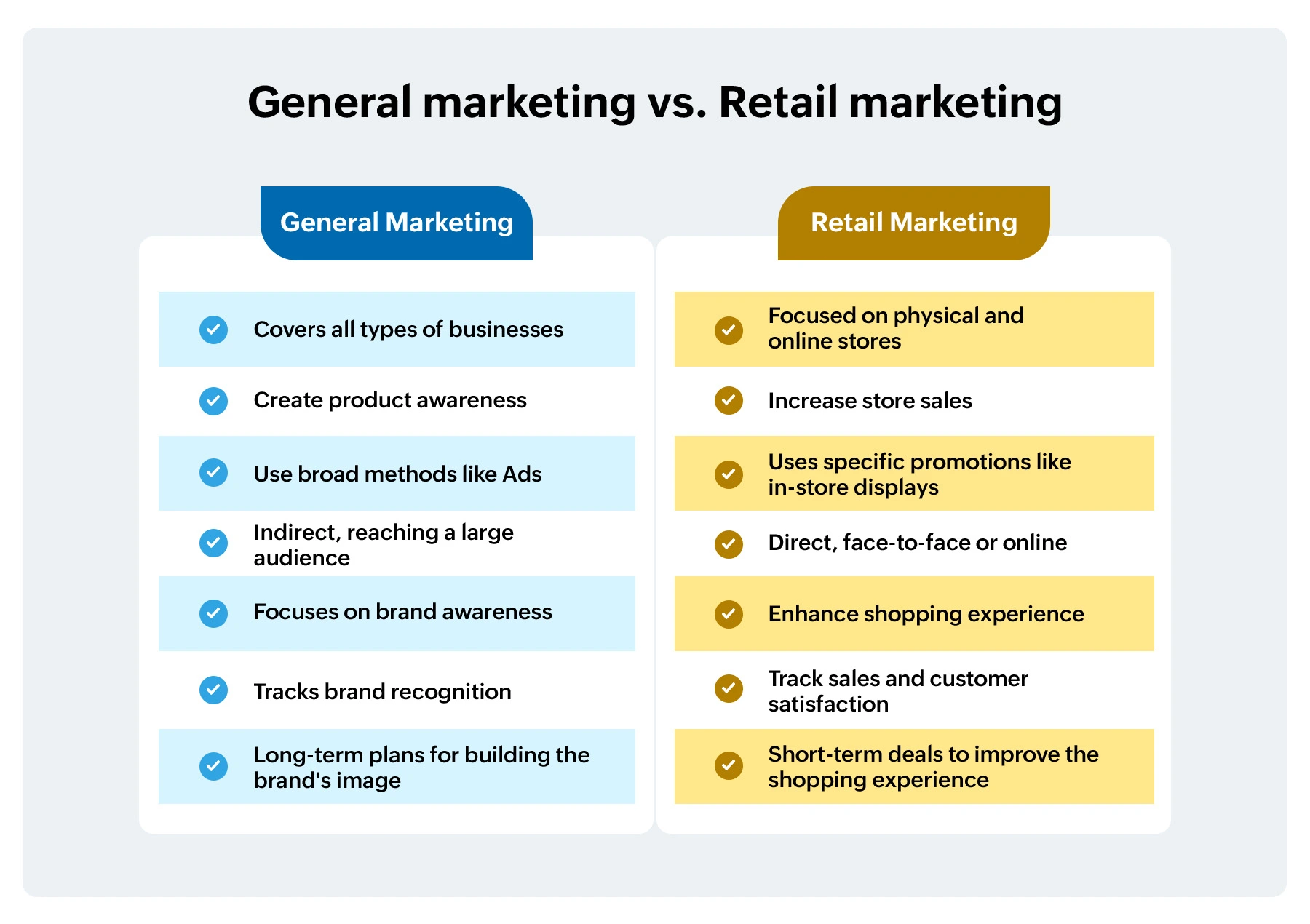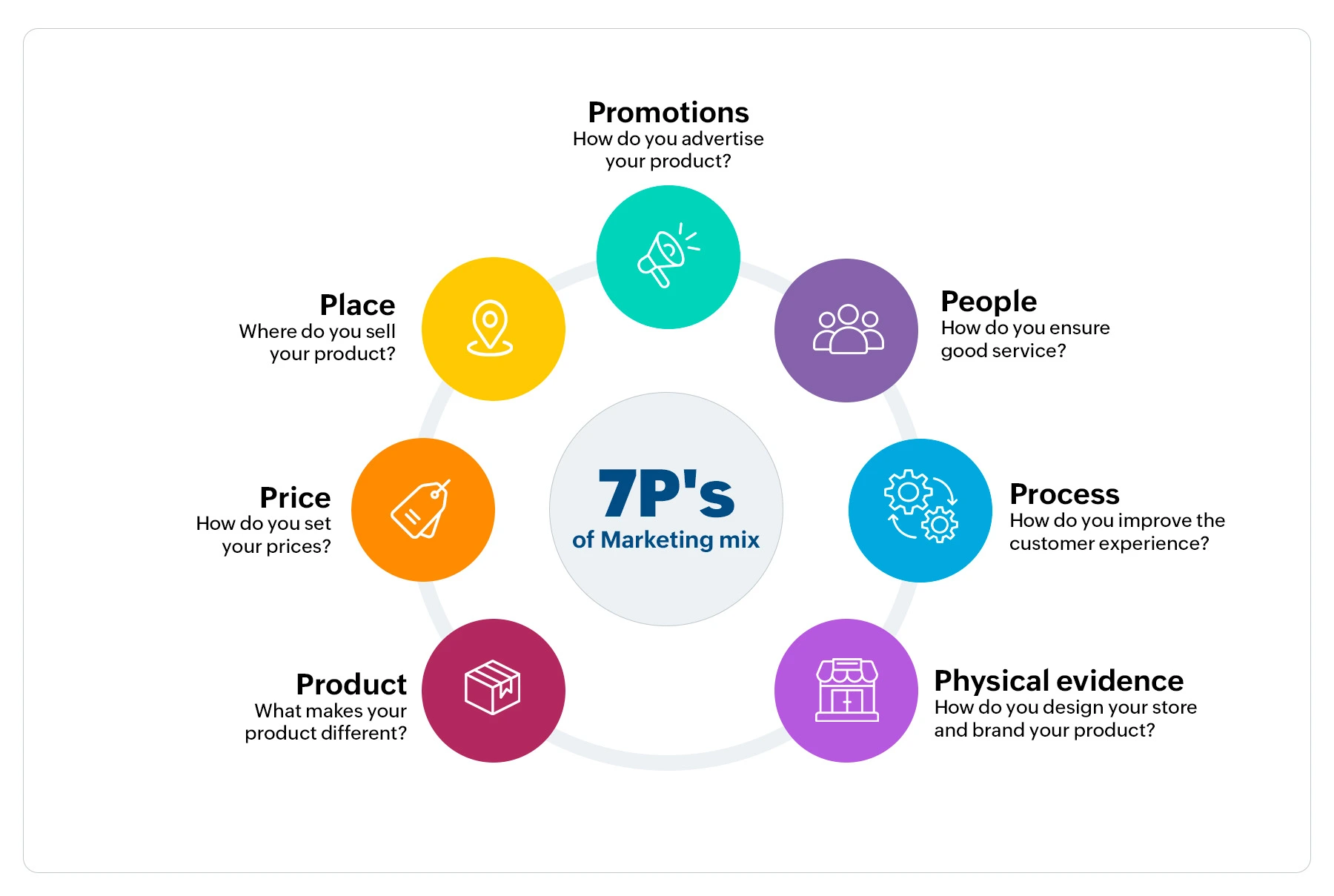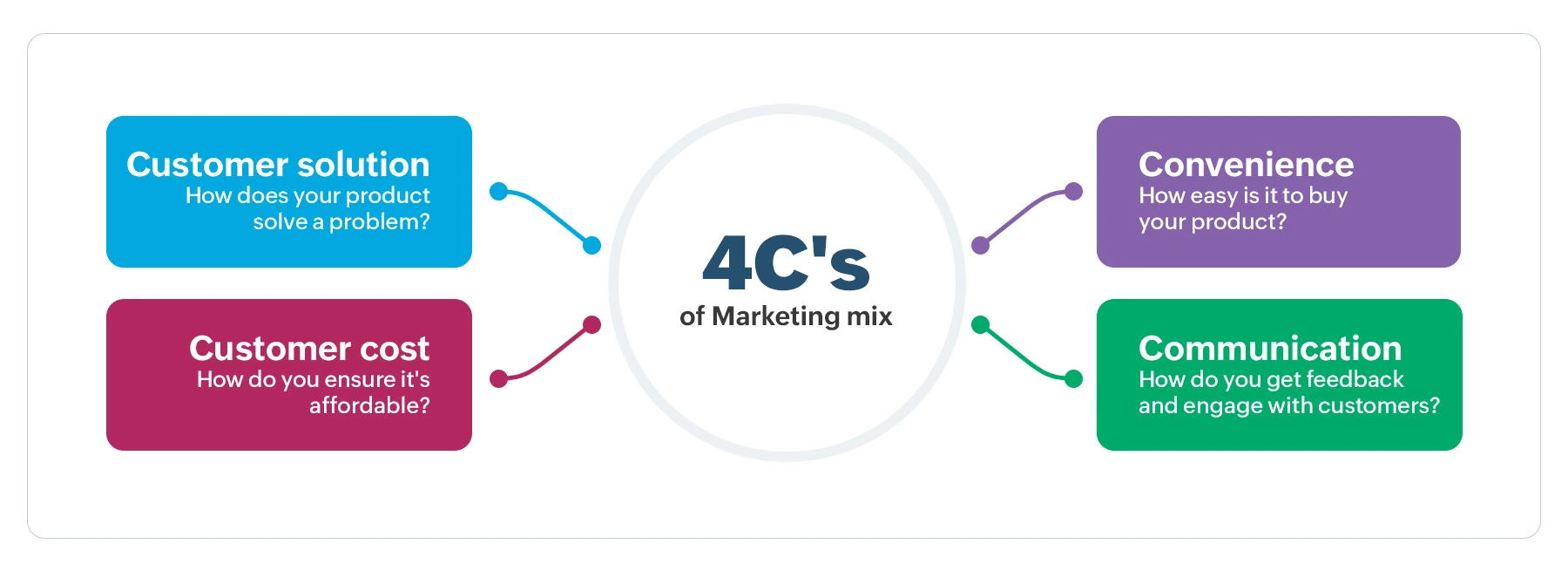Key takeaways:
- Understand what retail marketing is and how it helps businesses attract customers, encourage purchases, and build loyalty.
- Learn about practical tools and strategies, like the 7 Ps and 4 Cs, that make shopping easier and more enjoyable for customers.
- Discover how new trends and technology impact retail marketing and how stores can adapt to keep customers happy and coming back.
Imagine walking into your favourite local store. The staff greets you by name and remembers your last purchase. The store is neat, with eye-catching displays of new trends. You see a special offer on items you like, and your phone buzzes with an exclusive discount from the store’s app. This seamless and personalized experience is retail marketing in action. It’s about knowing what customers want, creating engaging shopping experiences, and promoting products to drive sales and build loyalty. This blog will explore the unique aspects of retail marketing and how it turns shoppers into loyal customers.
Contents:
- What is retail marketing?
- General marketing vs. retail marketing
- Importance of retail marketing
- Functions of retail marketing
- Types of retail marketing
- Retail marketing strategies
- What is the marketing mix?
- 7P's of retail marketing
- 4C's of retail marketing
- Factors influencing retail marketing
- Gofrugal's Customer case
What is retail marketing?
Retail marketing is a strategy businesses use to attract customers to their physical or online stores and encourage purchases. It involves understanding customer needs, creating engaging experiences, and effectively promoting products. The functions of retail marketing play a crucial role in ensuring businesses reach and retain their target audience.
- Attracting customers - Bringing in potential buyers through different methods, like advertisements, social media, and special events.
- Engaging customers - Keeping customers interested and connected with the brand by offering enjoyable experiences and personalized services.
- Driving sales - Encouraging purchases through special deals, discounts, and attractive offers.
- Building loyalty - Developing strong, long-term relationships with customers to ensure repeat business.
Understanding the importance of retail marketing helps businesses enhance customer experiences and optimize sales strategies.
How retail marketing differs from general marketing
General marketing includes all the ways businesses promote their products or services. This can be through advertisements, social media posts, emails, or any other method to get the word out. The main goal is to let people know about the product and convince them it's worth buying.
Retail marketing is more focused and specific. It aims to make the shopping experience enjoyable and easy for customers, whether they are in a physical store or shopping online. While general marketing gets people interested, retail marketing turns that interest into actual purchases by making the buying process as smooth and appealing as possible. Proper retail marketing management ensures businesses maximize revenue while enhancing customer satisfaction.

Unique features of retail marketing
Retail marketing has several unique features that distinguish it from general marketing. Understanding these features of retail marketing helps businesses enhance customer engagement and drive sales effectively.
- Direct interaction: This involves face-to-face interactions in stores or live chats online, allowing personalized customer service. Strong retail marketing management ensures that businesses maintain consistent and meaningful engagement with their customers.
- Point of sale focus: Retail marketing emphasizes strategies to encourage purchases at the moment, such as product placement, promotional displays, and checkout offers. These strategies align with key functions of retail marketing that drive conversions.
- Customer experience: It is crucial to create a pleasant shopping environment, both in-store and online. This includes store layout, website usability, personalization, and convenience.
Importance of retail marketing
Retail marketing is vital for businesses because it directly influences how customers perceive their shopping experience and, ultimately, their satisfaction. Businesses can tailor their marketing efforts to meet these expectations by deeply understanding what customers need and want. This approach attracts more customers and turns potential buyers into loyal patrons. Here’s why retail marketing is so crucial.
- Customer-centric approach: Retail marketing places the customer at the center of all activities. By focusing on customer needs and preferences, businesses can design strategies that resonate well with their target audience.
- Immediate impact on sales: Retail marketing activities, such as promotions, in-store displays, and personalized recommendations, immediately affect sales. When done right, these tactics can quickly convert interest into purchases.
- Building relationships: Unlike general marketing, which might focus on brand awareness, retail marketing emphasizes building a relationship with the customer. This relationship is key to customer retention and repeat business.
- Adapting to trends: Retail marketing allows businesses to be flexible and adapt to current market trends and consumer behaviors. This adaptability is essential for staying relevant and competitive in a dynamic market.
Functions of retail marketing
Understanding the functions of retail marketing helps businesses attract customers, enhance brand identity, and drive sales.
Customer engagement and retention
- Tailoring interactions based on individual customer preferences, such as sending personalized emails with product recommendations or special offers.
- Rewarding repeat customers with points, discounts, or exclusive offers, encouraging them to continue shopping with the brand.
- Actively seeking and acting on customer feedback through surveys, reviews, and direct communication to improve the shopping experience.
Brand positioning
- Ensuring all marketing communications convey the same core message and values across advertising, social media posts, and in-store signage.
- Developing a cohesive visual style, including logos, color schemes, fonts, and packaging to help customers easily recognize and remember the brand. These features of retail marketing strengthen brand identity.
- Clearly communicating what makes the brand different and better than competitors, such as superior product quality, exceptional customer service, or innovative features.
Sales promotion and advertising
- Providing temporary price reductions, buy-one-get-one deals, or free gifts with purchase to encourage immediate purchases.
- Running promotions tied to holidays, seasons, or special events, such as back-to-school sales or Black Friday deals.
- Utilizing TV, radio, online ads, and social media to reach a wider audience, attracting new customers and reminding existing ones of the brand.
Market research and analysis
- Conducting surveys to gather insights on customer satisfaction, preferences, and buying behavior to refine products and services. This aligns with the importance of retail marketing in adapting to consumer needs.
- Analyzing sales data to identify patterns, trends, and high-performing products, aiding in informed decisions about inventory, pricing, and marketing strategies.
- Monitoring competitors to understand their strengths, weaknesses, and strategies helps position the brand effectively and identify differentiation opportunities.
- Staying updated on industry trends and consumer behaviors through industry reports, trade shows, and social media, allowing for anticipation of changes and adaptation of retail marketing strategies.
Types of retail marketing
In-store marketing
In-store marketing uses tactics within physical stores to attract and engage customers.
- Signage: Eye-catching signs and banners that guide customers and highlight deals.
- Displays: Creative setups showcasing products attractively.
- In-store promotions: Special events and discounts to create excitement.
- Customer service: Friendly, knowledgeable staff providing assistance and recommendations.
Online marketing
Online marketing uses digital strategies to reach customers on the internet. Effective retail marketing management ensures businesses maintain a strong online presence. This includes:
- Websites: User-friendly sites with easy navigation and smooth checkouts.
- Email marketing: Personalized emails about new products and offers.
- Online ads: Digital ads on search engines (Google, Yahoo, Bing, and the like), social media, and other sites.
- SEO and content marketing: Optimized websites and valuable content to attract visitors.
- WhatsApp marketing: Using WhatsApp to send messages, updates, and special offers directly to customers.
Traditional marketing
Traditional marketing uses conventional methods to reach a broad audience. Despite digital advancements, these functions of retail marketing still hold value. This includes:
- Print ads: Advertisements in newspapers and magazines.
- Flyers and brochures: Printed materials distributed to provide information.
- Billboards and posters: Large ads in high-traffic areas for visibility.
Social media marketing
Social media marketing uses platforms like Facebook and Instagram to engage with customers. The importance of retail marketing on social media lies in its ability to build relationships and drive brand awareness. This includes:
- Content creation: Regular posts, photos, and videos to keep followers engaged.
- Influencer partnerships: Collaborating with popular users to expand reach.
- Social media ads: Targeted ads appearing in users' feeds and stories.
- Customer interaction: Responding to comments and messages to build relationships.
Omnichannel marketing
Omnichannel marketing creates a seamless experience across all shopping channels. This includes:
- Integrated online and offline experiences: Allowing customers to start shopping on one platform and continue on another.
- Unified customer data: Using customer information across all channels to provide personalized experiences.
- Consistent messaging: Maintaining your brand's voice and offers across all platforms.
Experiential marketing
Experiential marketing focuses on creating memorable experiences for customers.
- Pop-up shops: Temporary stores that offer unique, limited-time experiences.
- Virtual and augmented reality: Using technology to create immersive product experiences. For example, use your phone to see how a new couch would look in your living room before you buy it.
- Interactive product demonstrations: Allowing customers to engage with products in new and exciting ways before buying.
By utilizing these functions of retail marketing, businesses can reach customers through multiple channels, enhance engagement, and boost sales effectively.
Retail marketing strategies
Crafting effective retail marketing strategies is key to standing out in today’s market. These strategies focus on attracting the right customers, enhancing the shopping experience, and driving repeat business. Some common approaches include loyalty programs, personalized promotions, omnichannel engagement, and leveraging data-driven insights to fine-tune offers.
To explore proven strategies that can boost your retail success, check out our detailed blog on 9 Powerful retail marketing strategies that you should know.
What is the marketing mix?
The marketing mix is a set of tools that businesses use to promote and sell their products or services. It includes different elements that can be adjusted to meet customer needs and achieve business goals. By carefully managing these elements, businesses can attract customers, improve their market presence, and stay competitive. Effective retail marketing management ensures that these elements work together to maximize sales and customer satisfaction.
Importance of a balanced marketing mix
Having a balanced marketing mix is essential for several reasons.
Meeting customer needs: By carefully planning each component, businesses can ensure they meet their customers' needs effectively. For example, offering a high-quality product at a fair price, available in convenient locations, and promoted in a way that resonates with the target audience reflects the core functions of retail marketing.
Competitive advantage: A well-balanced marketing mix helps a business stand out from its competitors. By offering something unique or superior, a business can attract more customers and build a loyal customer base. This is one of the essential features of retail marketing that drive sustained growth.
Adaptability: In retail marketing management, adaptability is key. The marketing mix allows businesses to adapt to changes in the market. For instance, if a new competitor enters the market, a business might adjust its pricing strategy or enhance its promotional efforts to maintain its market position.
Optimizing resources: By understanding which components of the marketing mix are most effective, businesses can allocate their resources more efficiently. This means spending money and time on strategies that yield the best results, leading to better overall performance.
Consistent brand message: A balanced marketing mix ensures all aspects of marketing work together to deliver a consistent message. This helps build a strong brand identity and make sure customers understand what the brand stands for.
Importance of 7 Ps and 4 Cs in retail marketing strategies
7 Ps of marketing

Product
- Make sure the design and features of your products meet customer needs and preferences.
- Consider the entire lifecycle, from introduction to decline, to keep the product relevant and valuable.
- Highlight what makes your product different from competitors.
Price
- Set prices based on production costs, competitor prices, and what customers are willing to pay.
- Offer discounts, special deals, or seasonal promotions to boost sales and attract new customers.
Place
- Decide where your products will be sold (stores, online).
- Ensure a smooth shopping experience in both physical and online stores.
Promotion
- Use various advertising methods, such as online ads, TV commercials, and social media campaigns, to reach a wide audience.
- Offer promotions like limited-time offers or contests to create buzz and attract customers.
- Build a good image and use sales tactics to boost sales.
People
- Train staff to provide excellent service.
- Keep employees happy to ensure they serve customers well.
Process
- Make your operations efficient to improve service delivery. Streamlined processes can reduce costs and enhance the customer experience.
- Ensure a smooth and enjoyable shopping journey from start to end.
Physical evidence
- Create an attractive and functional store layout that enhances the shopping experience.
- Ensure your branding and packaging reflect the quality and identity of your product.
4 Cs of marketing

Customer solution
- Understand and fulfill customer needs with your products.
- Highlight the benefits and features of your products that address customer needs and desires.
- Promote how your product can make a difference clearly.
Customer cost
- Consider all costs that a customer incurs, not just the price. This includes time, effort, and any additional expenses related to using your product.
- Ensure customers see your product as worth the cost.
Convenience
- Make it easy for customers to buy your products. This includes having an intuitive online store, convenient payment options, and quick delivery.
- Ensure your products are accessible where your customers shop, whether in physical locations or online. Consider varied delivery options and store locations.
Communication
- Engage with customers through open communication channels.
- Implement systems to gather customer feedback and use it to improve your products and services.
Factors influencing retail marketing
Retail marketing is affected by various factors that can change how businesses reach and interact with customers. Understanding these factors is crucial for effective retail marketing management, allowing businesses adapt their strategies to stay relevant and competitive. Here are some key factors influencing retail marketing.
Consumer habits and trends
Consumer behavior plays a vital role in the functions of retail marketing:
- Some customers prefer online shopping for convenience, while others like visiting physical stores for the experience.
- Customers now expect personalized experiences, from product recommendations to customized marketing messages.
New technology
Technological advancements significantly impact the importance of retail marketing:
- Online shopping platforms make it easy for customers to buy products from anywhere.
- AI helps personalize customer experiences, optimize inventory, and provide customer support through chatbots.
Social commerce
Social commerce has become one of the vital channels in retail marketing:
- Social media platforms are becoming direct sales channels with features like Instagram Shopping and Facebook Marketplace.
- Influencer marketing is evolving, with micro-influencers gaining importance for niche markets.
Mobile-first approach
A strong mobile strategy is central to the functions of retail marketing:
- With the majority of online shopping now happening on mobile devices, retailers are prioritizing mobile-friendly websites and apps.
- Mobile payment options and digital wallets are becoming increasingly important.
Voice commerce
Voice commerce is a growing trend in retail marketing:
- The rise of smart speakers and voice assistants is creating new opportunities for voice-activated shopping.
- Retailers are optimizing their product information for voice search to stay competitive in this emerging channel.
Economic conditions
Economic factors affect how retail marketing strategies are crafted:
- When the economy is strong, consumers are more likely to spend money. During economic downturns, spending tends to decrease.
- Rising prices can affect consumer purchasing power, leading to changes in buying habits.
Competition
Competition drives innovation and strategic shifts in retail marketing management:
- Businesses need to differentiate themselves through unique products, superior service, or innovative marketing.
- Competitors may engage in price wars to attract customers, impacting profit margins.
Laws and regulations
Compliance is an essential part of the functions of retail marketing:
- Regulations that protect consumer rights, such as return policies and warranty standards.
- Regulations like the General Data Protection Regulation (GDPR) that protect consumer data and privacy.
- Laws that govern truthful advertising, ensuring marketing messages are not misleading.
A multi-outlet retail store optimizes billing and inventory seamlessly with Gofrugal
One of our long-term customers scaled from e-commerce to a thriving multistore chain with Gofrugal! They share how Gofrugal simplified inventory management, sales tracking, and GST compliance for their pooja shopping business.
In conclusion, retail marketing is essential for businesses to attract customers, engage them, drive sales, and build loyalty. By understanding the unique features of retail marketing, recognizing its importance, and effectively utilizing the marketing mix and various marketing types, retailers can create successful strategies. Additionally, being aware of the external and internal factors influencing retail marketing helps businesses stay competitive and adapt to changing market conditions. A well-rounded retail marketing strategy ensures a positive shopping experience, ultimately leading to customer satisfaction and business growth.


